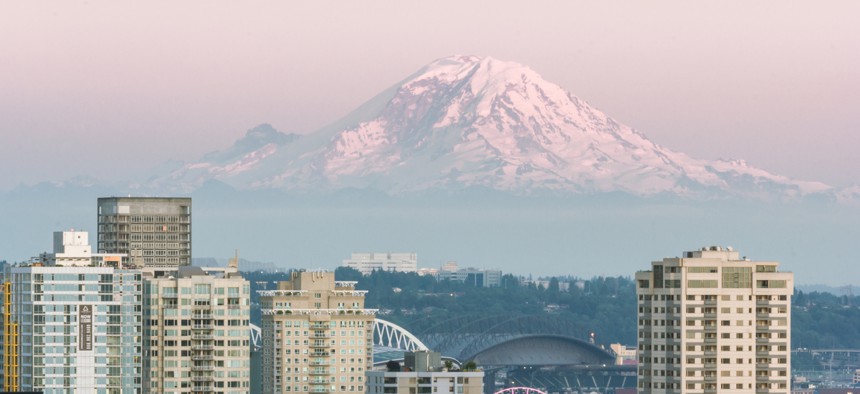State and Local Officials Press for More Resources to Reduce Risks From Natural Hazards

Mount Rainier as seen from Seattle Shutterstock
“Over the last half-dozen years every one of our federal and state funding lines has been cut back,” according to Alaska Earthquake Center seismologist Mike West.
WASHINGTON — Parts of the U.S. face gaps when it comes to monitoring equipment and other systems for mitigating risks from natural hazards like earthquakes, volcanoes and landslides, according to state and local officials who spoke with Senate lawmakers here this week.
The discussion took place only about a week after a 7.9 magnitude earthquake, centered in the Gulf of Alaska, caused a tsunami scare that forced people to evacuate from coastal areas.
One of the places jolted by the quake was the city of Kodiak, Alaska. “We are very vulnerable, certainly not just Kodiak, but Alaska and other remote communities as well,” the city’s mayor, Pat Branson, said in testimony to the Senate Energy and Natural Resources Committee.
With about 6,200 residents, Kodiak is located on an island off of Alaska’s southern coast.
The mayor described shortcomings the city has with emergency staffing and communications technology. She also said the local fire station was nearly inundated by a tsunami in the 1960s and was damaged in last week’s quake.
Mike West, a seismologist with the Alaska Earthquake Center, explained that around the time the recent tremblor struck, some of the center’s computer network was knocked offline for an hour or so due to an unrelated power outage. “Not a proud moment,” he said.
The center, which provides information derived from seismic monitoring stations to the public, emergency managers and others, has made it clear for several years that it does not have full backup systems in place to seamlessly handle a situation like the outage, according to West.
“The reason is very simple,” he said. “Over the last half-dozen years every one of our federal and state funding lines has been cut back.”
Dave Norman, a geologist with Washington state’s Department of Natural Resources, noted that the state is home to four of the nation’s “very high threat” volcanoes. With the exception of Mount St. Helens, which erupted in 1980, the U.S. Geological Survey has indicated that each of these volcanoes is “under-monitored,” he said, given the risks they pose.
“Several of our volcanoes in Washington state, and California, Oregon, Alaska, they have either no seismic monitors on them at all, or they have one,” Norman explained to Route Fifty after the hearing. “That means when you start to have some sort of rumbling below the volcano, if you don’t have a monitor on it, you really can’t tell what kind of a signal it’s sending you.” He said that generally the minimum number of seismic monitors required to take good readings is about five.
Mount Rainier presents an especially dangerous volcano threat, according to Norman. “It does have some monitoring on it, but probably not enough given its size and its proximity to population,” he added. The mountain is located about 60 miles southeast of Seattle.

Norman voiced support for the National Volcano Early Warning and Monitoring System Act, and told the committee the legislation would help fund monitoring efforts. Sen. Lisa Murkowski, the Alaska Republican who chairs the Energy and Natural Resources Committee, sponsored the bill and said Tuesday that it is part of a legislative package awaiting consideration on the Senate floor.
Murkowski noted that the National Landslide Preparedness Act, aimed at understanding and reducing landslide risks, is also part of the package.
Those on hand at Tuesday’s meeting discussed landslide and avalanche hazards as well. Norman said that hazard maps for landslides are far from complete and that additional research and monitoring equipment could help to reduce the dangers that the slides pose.
Mudslides killed at least 21 people in California earlier this month. A massive slide near Oso, Washington in 2014 claimed 43 lives. And a slow-moving slide is currently occurring on Rattlesnake Ridge, near Yakima, Washington, along a stretch of Interstate 82.
Bill Lucia is a Senior Reporter for Government Executive’s Route Fifty and is based in Washington, D.C.
NEXT STORY: Minneapolis puts new video platform to work for Super Bowl policing






